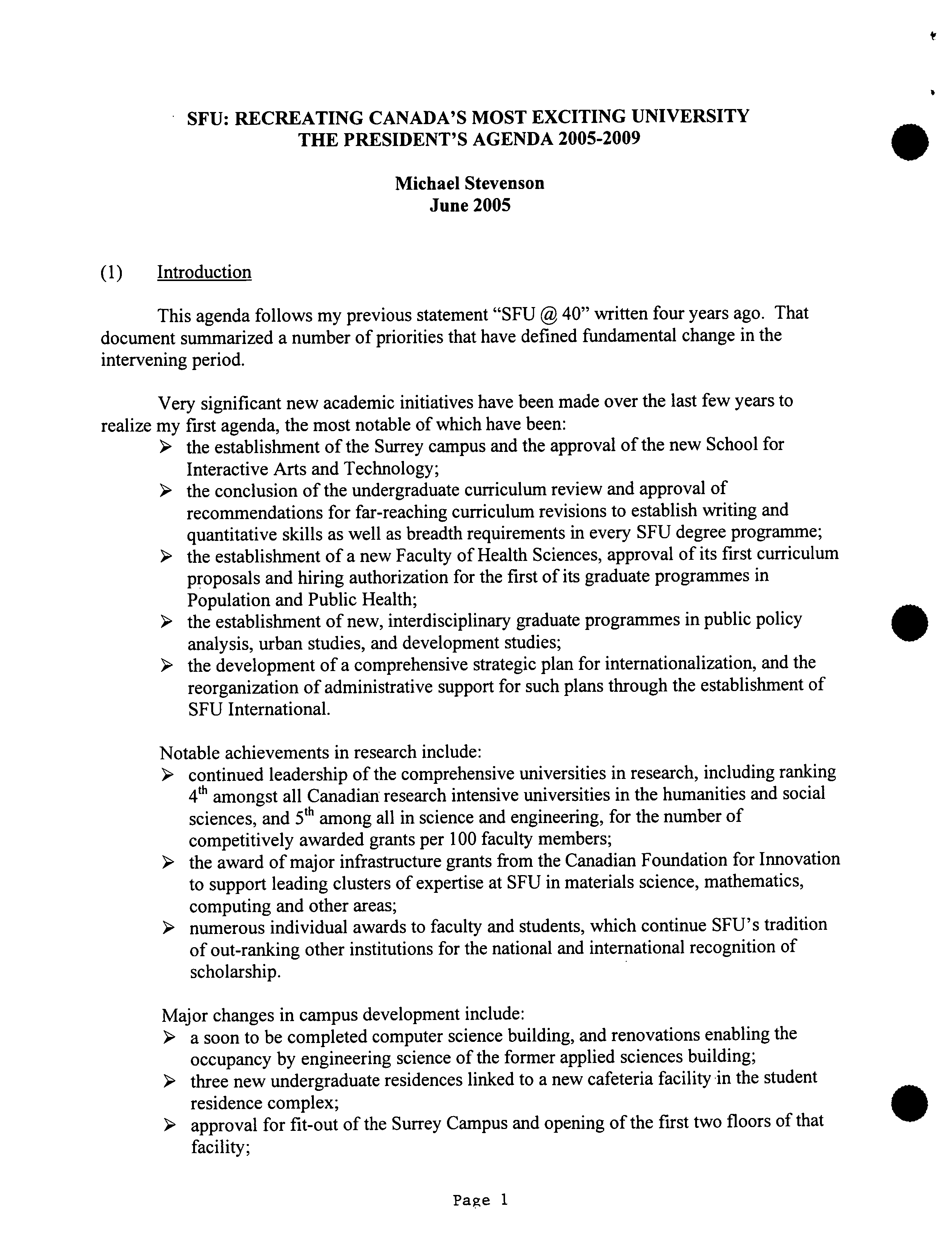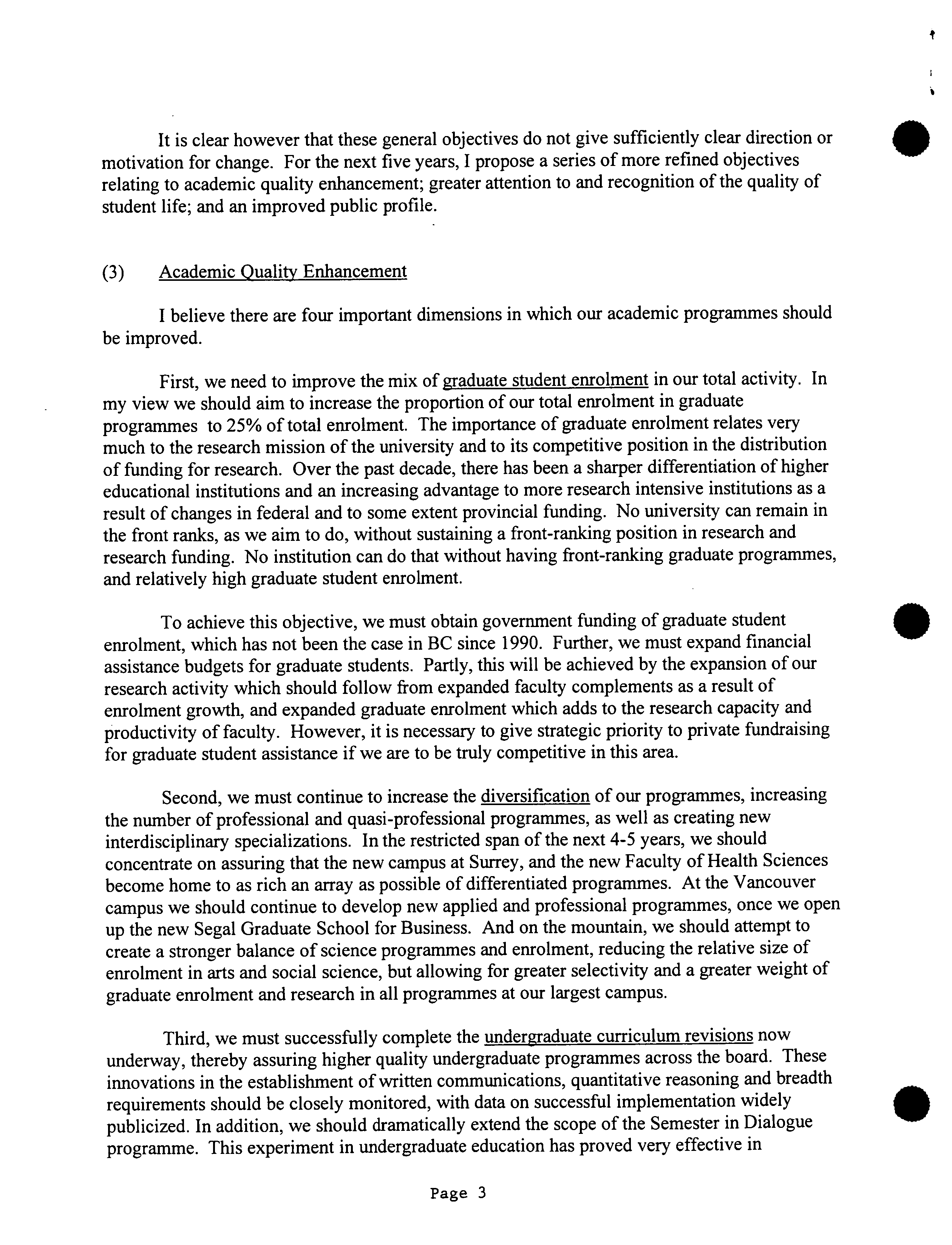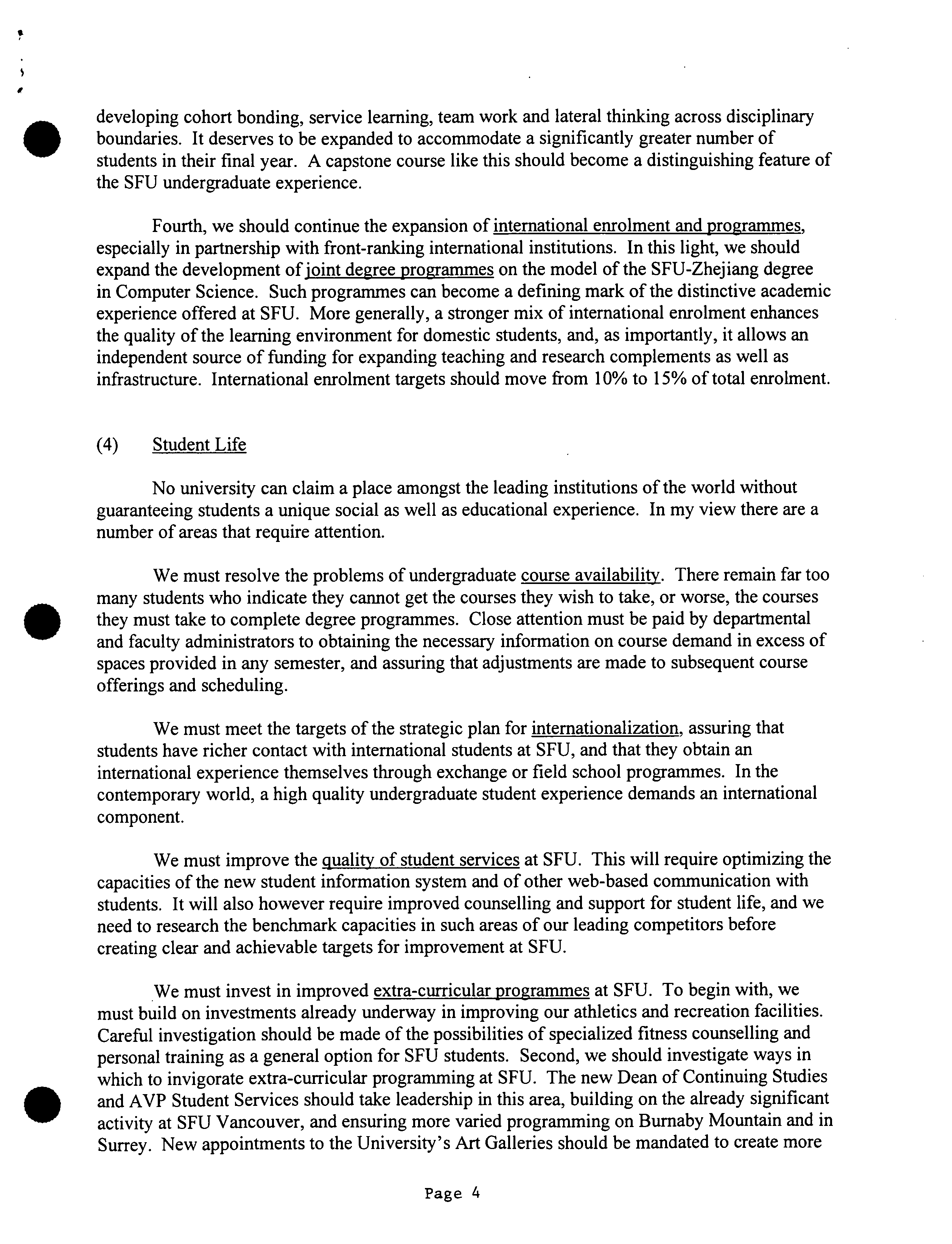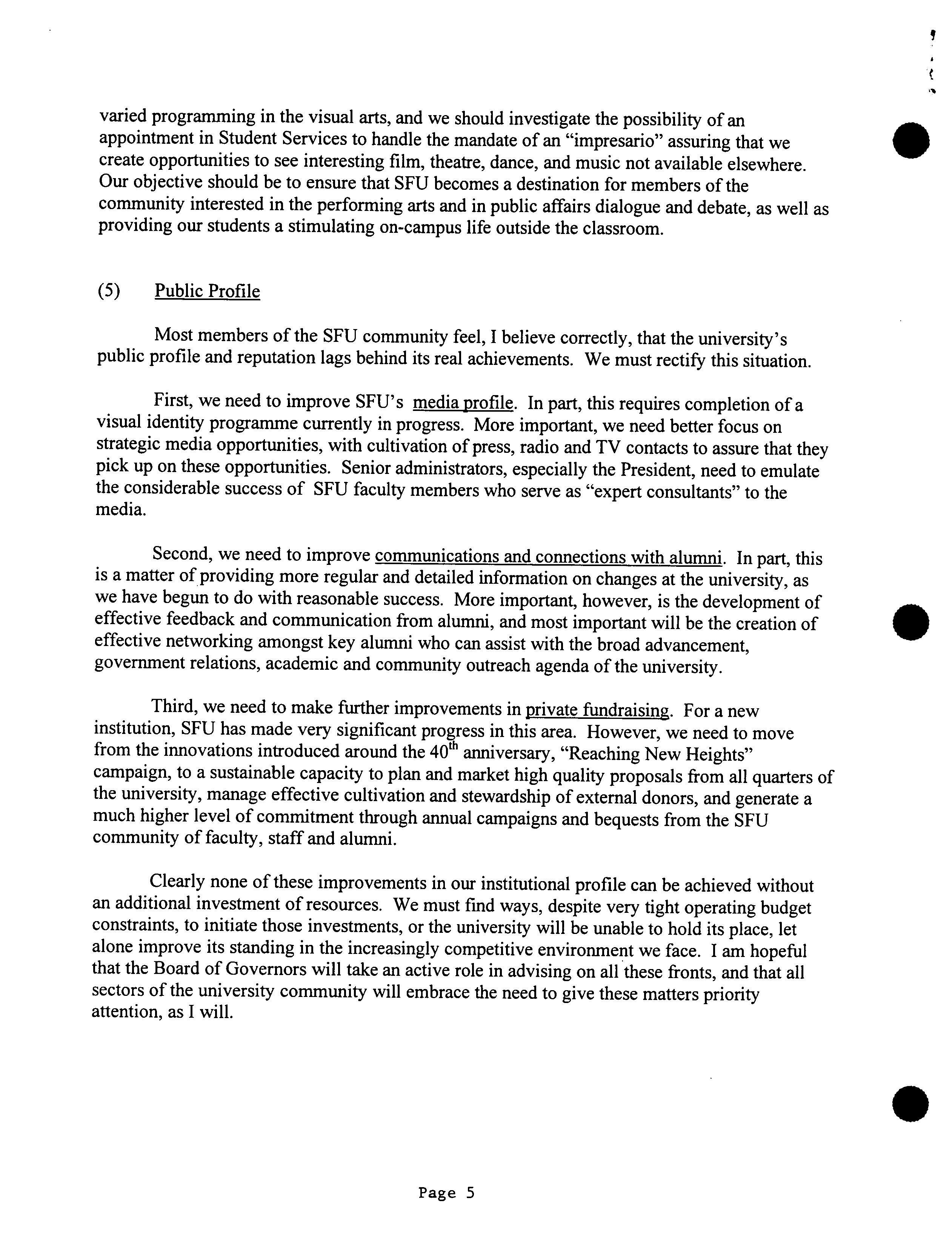S.05-109
.
SIMON FRASER UNIVERSITY
University Secretariat
MEMORANDUM
To:
Senate
From:
Alison Watt
Subject:
President Stevenson's Agenda 2005-2009
Date:
October 13, 2005
FOR INFORMATION
The Board of Governors approved the President's agenda at its meeting on September
29, 2005. This is forwarded to Senate for information and discussion at the November 7,
2005 meeting.
.
Room 3186, Strand Hall
8888 University Drive, Burnaby, B.C. V5A 1S6
SFU: RECREATING CANADA'S MOST EXCITING UNIVERSITY
THE PRESIMDEicNhaeT'l S
SAteGveEnNson
DA 2005-2009
0
June 2005
(1)
Introduction
This agenda follows my previous statement "SFU 40" written four years ago. That
document summarized a number of priorities that have defined fundamental change in the
intervening period.
Very significant new academic initiatives have been made over the last few years to
realize my first agenda, the most notable of which have been:
> the establishment of the Surrey campus and the approval of the new School for
Interactive Arts and Technology;
the conclusion of the undergraduate curriculum review and approval of
recommendations for far-reaching curriculum revisions to establish writing and
quantitative skills as well as breadth requirements in every SFU degree programme;
> the establishment of a new Faculty of Health Sciences, approval of its first curriculum
proposals and hiring authorization for the first of its graduate programmes in
Population and Public Health;
the establishment of new, interdisciplinary graduate programmes in public policy
analysis, urban studies, and development studies;
the development of a comprehensive strategic plan for internationalization, and the
reorganization of administrative support for such plans through the establishment of
SFU International.
Notable achievements in research include:
> continued leadership of the comprehensive universities in research, including ranking
4th amongst all Canadian research intensive universities in the humanities and social
sciences, and
5th
among all in science and engineering, for the number of
competitively awarded grants per 100 faculty members;
> the award of major infrastructure grants from the Canadian Foundation for Innovation
to support leading clusters of expertise at SFU in materials science, mathematics,
computing and other areas;
numerous individual awards to faculty and students, which continue SFU's tradition
of out-ranking other institutions for the national and international recognition of
scholarship.
Major changes in campus development include:
a soon to be completed computer science building, and renovations enabling the
occupancy by engineering science of the former applied sciences building;
> three new undergraduate residences linked to a new cafeteria facility in the student
raepprsideovancl e
fcor
omfitpl-out
ex;
of the Surrey Campus and opening of the first two floors of that
0
facility;
Page 1
•
> completion early in the next academic year of the new Segal Graduate School for
Business as part of the Vancouver campus;
> approval of projects to build a new science and applied science building, a new arts
and social science building, a new health sciences building, and a new gymnasium
and recreation facility;
> approval for the relocation of the School for Contemporary Arts as part of the
Woodward's redevelopment in downtown Vancouver.
Major efforts have been made to diversify funding in support of the university. Tuition
has been increased significantly across the board, and differential fees have been introduced in
higher cost programmes, and for international students. These increases have allowed the
university to manage declining per FTE grants without any compromise in quality, and to invest
in infrastructural and other initiatives not funded by government. We have also made major
strides towards realizing new fundraising targets which entail a four- to five-fold increase in
endowments and other financial contributions to the university in the period 2000-05 as
compared to the preceding five years. The Reaching New Heights campaign is in its final phase,
and we are confident of realizing a $125 million target by the end of the
40th
anniversary year.
(2)
Environmental Scan
The broad environmental pressures confronting the university remain essentially
•
unchanged from the time I outlined my first agenda, although progress has been made on two
fronts. Recent government action has substantially addressed the problems of demand for and
accessibility to higher educational institutions in B.C. with the commitment to fund an additional
25,000 seats throughout the province. And the chronic facilities and infrastructure deficit faced
at the beginning of the decade will be addressed to a large extent by projects to build academic
and other facilities at SFU valued at close to $400,000,000.00.
In both these areas, however, there remain important concerns. SFU, like the other BC
universities, has yet to receive adequate grant funding for these new enrolment targets, and
enrolment growth will compromise quality at current funding commitments. The infrastructure
requirements have also not been fully met. Despite very significant government financing of key
projects, government funding covers only about 75% of the space requirements previously
agreed to as necessary for the match of academic facilities to enrolment targets. Further, we face
unprecedented inflation in construction costs within the Lower Mainland. Again, therefore,
absent future improvements in infrastructure funding, we cannot sustain quality.
Other pressures remain: intensifying national and international competition in higher
education; the increasing necessity of diversified sources of funding; the increasing pressure for
engagement with external communities, and the increasing demand for greater accountability to
external stakeholders.
In these circumstances, our general objectives must remain: to establish
is
the best liberal arts and science education in Canada;
the most innovative interdisciplinary and professional programmes; and
the most responsive engagement with the broader community.
Page 2
It is clear however that these general objectives do not give sufficiently clear direction or
motivation for change. For the next five years, I propose a series of more refined objectives
relating to academic quality enhancement; greater attention to and recognition of the quality of
student life; and an improved public profile.
(3)
Academic Quality Enhancement
I believe there are four important dimensions in which our academic programmes should
be improved.
First, we need to improve the mix of graduate student enrolment in our total activity. In
my view we should aim to increase the proportion of our total enrolment in graduate
programmes to
25%
of total enrolment. The importance of graduate enrolment relates very
much to the research mission of the university and to its competitive position in the distribution
of funding for research. Over the past decade, there has been a sharper differentiation of higher
educational institutions and an increasing advantage to more research intensive institutions as a
result of changes in federal and to some extent provincial funding. No university can remain in
the front ranks, as we aim to do, without sustaining a front-ranking position in research and
research funding. No institution can do that without having front-ranking graduate programmes,
and relatively high graduate student enrolment.
To achieve this objective, we must obtain government funding of graduate student
enrolment, which has not been the case in BC since 1990. Further, we must expand financial
assistance budgets for graduate students. Partly, this will be achieved by the expansion of our
research activity which should follow from expanded faculty complements as a result of
enrolment growth, and expanded graduate enrolment which adds to the research capacity and
productivity of faculty. However, it is necessary to give strategic priority to private fundraising
for graduate student assistance if we are to be truly competitive in this area.
Second, we must continue to increase the diversification of our programmes, increasing
the number of professional and quasi-professional programmes, as well as creating new
interdisciplinary specializations. In the restricted span of the next 4-5 years, we should
concentrate on assuring that the new campus at Surrey, and the new Faculty of Health Sciences
become home to as rich an array as possible of differentiated programmes. At the Vancouver
campus we should continue to develop new applied and professional programmes, once we open
up the new Segal Graduate School for Business. And on the mountain, we should attempt to
create a stronger balance of science programmes and enrolment, reducing the relative size of
enrolment in arts and social science, but allowing for greater selectivity and a greater weight of
graduate enrolment and research in all programmes at our largest campus.
Third, we must successfully complete the undergraduate curriculum revisions now
underway, thereby assuring higher quality undergraduate programmes across the board. These
innovations in the establishment of written communications, quantitative reasoning and breadth
requirements should be closely monitored, with data on successful implementation widely
publicized. In addition, we should dramatically extend the scope of the Semester in Dialogue
programme. This experiment in undergraduate education has proved very effective in
Page
3
developing cohort bonding, service learning, team work and lateral thinking across disciplinary
boundaries. It deserves to be expanded to accommodate a significantly greater number of
students in their final year. A capstone course like this should become a distinguishing feature of
the SFU undergraduate experience.
Fourth, we should continue the expansion of international enrolment and programmes,
especially in partnership with front-ranking international institutions. In this light, we should
expand the development of joint degree programmes on the model of the SFU-Zhejiang degree
in Computer Science. Such programmes can become a defining mark of the distinctive academic
experience offered at SFU. More generally, a stronger mix of international enrolment enhances
the quality of the learning environment for domestic students, and, as importantly, it allows an
independent source of funding for expanding teaching and research complements as well as
infrastructure. International enrolment targets should move from 10% to 15% of total enrolment.
(4)
Student Life
No university can claim a place amongst the leading institutions of the world without
guaranteeing students a unique social as well as educational experience. In my view there are a
number of areas that require attention.
We must resolve the problems of undergraduate course availability. There remain far too
•
many students who indicate they cannot get the courses they wish to take, or worse, the courses
they must take to complete degree programmes. Close attention must be paid by departmental
and faculty administrators to obtaining the necessary information on course demand in excess of
spaces provided in any semester, and assuring that adjustments are made to subsequent course
offerings and scheduling.
We must meet the targets of the strategic plan for internationalization, assuring that
students have richer contact with international students at SFU, and that they obtain an
international experience themselves through exchange or field school programmes. In the
contemporary world, a high quality undergraduate student experience demands an international
component.
We must improve the quality of student services at SFU. This will require optimizing the
capacities of the new student information system and of other web-based communication with
students. It will also however require improved counselling and support for student life, and we
need to research the benchmark capacities in such areas of our leading competitors before
creating clear and achievable targets for improvement at SFU.
We must invest in improved extra-curricular programmes at SFU. To begin with, we
must build on investments already underway in improving our athletics and recreation facilities.
Careful investigation should be made of the possibilities of specialized fitness counselling and
personal training as a general option for SFU students. Second, we should investigate ways in
which to invigorate extra-curricular programming at SFU. The new Dean of Continuing Studies
and AVP Student Services should take leadership in this area, building on the already significant
activity at SFU Vancouver, and ensuring more varied programming on Burnaby Mountain and in
Surrey. New appointments to the University's Art Galleries should be mandated to create more
Page 4
varied programming in the visual arts, and we should investigate the possibility of an
appointment in Student Services to handle the mandate of an "impresario" assuring that we
create opportunities to see interesting film, theatre, dance, and music not available elsewhere.
Our objective should be to ensure that SFU becomes a destination for members of the
community interested in the performing arts and in public affairs dialogue and debate, as well as
providing our students a stimulating on-campus life outside the classroom.
(5)
Public Profile
Most members of the SFU community feel, I believe correctly, that the university's
public profile and reputation lags behind its real achievements. We must rectify this situation.
First, we need to improve SFU's media
p
rofile. In part, this requires completion of a
visual identity programme currently in progress. More important, we need better focus on
strategic media opportunities, with cultivation of press, radio and TV contacts to assure that they
pick up on these opportunities. Senior administrators, especially the President, need to emulate
the considerable success of SFU faculty members who serve as "expert consultants" to the
media.
Second, we need to improve communications and connections with alumni. In part, this
is a matter of providing more regular and detailed information on changes at the university, as
we have begun to do with reasonable success. More important, however, is the development of
effective feedback and communication from alumni, and most important will be the creation of
effective networking amongst key alumni who can assist with the broad advancement,
government relations, academic and community outreach agenda of the university.
Third, we need to make further improvements in private fundraising. For a new
institution, SFU has made very significant progress in this area. However, we need to move
from the innovations introduced around the 40th anniversary, "Reaching New Heights"
campaign, to a sustainable capacity to plan and market high quality proposals from all quarters of
the university, manage effective cultivation and stewardship of external donors, and generate a
much higher level of commitment through annual campaigns and bequests from the SFU
community of faculty, staff and alumni.
Clearly none of these improvements in our institutional profile can be achieved without
an additional investment of resources. We must find ways, despite very tight operating budget
constraints, to initiate those investments, or the university will be unable to hold its place, let
alone improve its standing in the increasingly competitive environment we face. I am hopeful
that the Board of Governors will take an active role in advising on all these fronts, and that all
sectors of the university community will embrace the need to give these matters priority
attention, as I will.
.
Page 5






